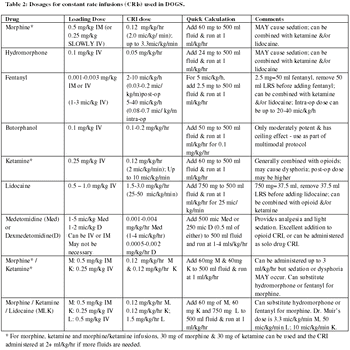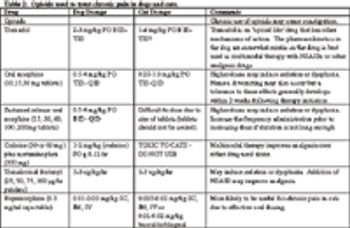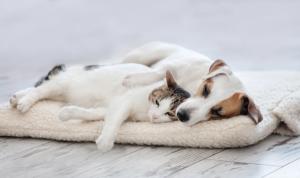
Plus, frequently asked questions

Tamara Grubb, DVM, PhD, DACVAA, is a board-certified veterinary anesthesiologist with a strong clinical interest and research focus in pain management. She is President-Elect of the International Veterinary Academy of Pain Management (IVAPM), a certified veterinary acupuncturist and a consultant in a private small-animal veterinary practice.

Plus, frequently asked questions

An expert provides answers to frequently asked questions

By recognizing physiologic, physical, and behavioral signs of pain and employing a consistent pain scoring system, veterinary teams can improve their assessment of cats in need of analgesic therapy. And by administering FDA-approved analgesic drugs in multimodal protocols, veterinarians can provide effective pain relief for their feline patients.

Because we want to succeed! If we want to do the best medicine possible and give our patients the best chance to heal, then we have to treat pain. Pain initiates a fairly profound stress response and a sympathetic overdrive. Stress and autonomic imbalance are not benign and the cascade of side effects include gastrointestinal (GI) ileus, GI ulceration, clotting dysfunction, hypertension, tachycardia, tachyarrhythmias, and many others.

Acute pain has an initial biological purpose in that it initiates a protective withdrawal reflex when a painful stimulus is encountered so that the tissue damage is minimized. Because of its usefulness, acute pain is often called 'physiologic pain'. Unfortunately, unlike acute pain, chronic pain serves no biological purpose.

No matter what anesthetic protocol is chosen, the addition of adequate analgesia is imperative for safe anesthesia. Most anesthetic agents, including the anesthetic gases, block the brain's response to pain but don't actually block pain. If the pain is severe enough, the brain can still respond and make the animal appear to be inadequately anesthetized.

Local anesthetic drugs are extremely effective, inexpensive and easy to use. When local anesthetic drugs are administered, pain impulses originating in the periphery are blocked and prevented from reaching the central nervous system.

Our patient population has changed fairly dramatically in the last 10 years as our medical skills have progressed and we have become capable of supporting patients with advanced disease and advancing age. With this new set of patients comes a new set of problems, like chronic pain.

Our patient population has changed fairly dramatically in the last 10 years as our medical skills have progressed and we have become capable of supporting patients with advanced disease and advancing age.

Constant rate infusions (CRI) of analgesic drugs are an excellent way to manage pain in both dogs and cats.

Opioids are a group of natural derivatives or synthetic relatives of opium, which is extracted from the exudate of seedpods of the opium poppy, Papaver somniferum. The poppy plant appears to have been cultivated in ancient civilizations, like those of Persia, Egypt and Mesopotamia, and the first known written reference to the poppy appears in 4,000 BC (from 'A Brief History of Opium' at http://opiates.net).

Pain management is a win/win situation for both the patient and the practice. The appropriately analgesed patient has a better quality of life and heals faster, while the practice increases profits and client satisfaction. There is no negative impact of good pain management in the practice and every practice should strive to have the best pain management practices possible.

Cats can be difficult to safely anesthetize because of their small body size, fractious nature and altered metabolism of anesthetic drugs. Furthermore, cats are frequently undertreated for pain.

Constant rate infusions (CRI) of analgesic drugs are an excellent way to manage pain in both dogs and cats. A CRI of analgesic agents has several advantages over multiple repeated injections for pain relief.

No matter what anesthetic protocol is chosen, the addition of adequate analgesia is imperative for safe anesthesia and for enhanced patient outcome.

Our patient population has changed fairly dramatically in the last 10 years as our medical skills have progressed and we have become capable of supporting patients with advanced disease and advancing age. Now we must hone our anesthesia skills in order to support patients that largely don't fit into the 'young, healthy' category and it is no longer appropriate to think that safe anesthesia means recovering as many patients as we anesthetize.

Anesthesia should be thought of as 4 distinct and equally important periods: 1) preparation/premedication; 2) induction; 3) maintenance and 4) recovery. We tend to diminish the importance of the phases of preparation/premedication and recovery and yet these phases contribute as much to successful anesthesia as the phases of induction and maintenance.

Because the airway extends from the oral or nasal cavity to the alveoli, respiratory compromise has numerous manifestations. Complications can be encountered in both the upper and lower airways.

The most effective way to deal with anesthetic emergencies is to prevent them and appropriate 1) stabilization of the patient, 2) selection of type and dosage of anesthetic drugs, 3) preparation of anesthetic equipment, 4) pre-, post- and intra-operative support of the patient, and 4) physiologic monitoring, will make the anesthetic episode safer and will decrease the likelihood of anesthetic emergencies.

Published: July 22nd 2022 | Updated:

Published: August 1st 2010 | Updated:

Published: August 1st 2010 | Updated:

Published: August 1st 2010 | Updated:

Published: August 1st 2010 | Updated:

Published: August 1st 2010 | Updated: